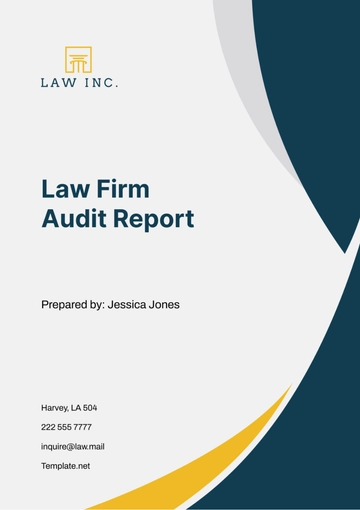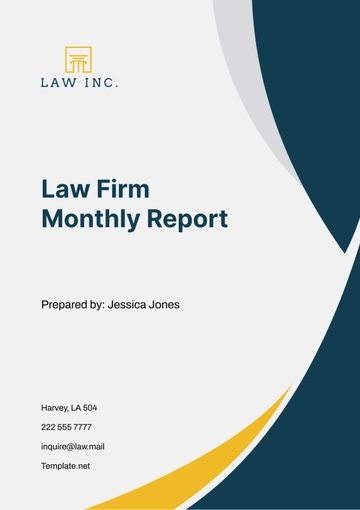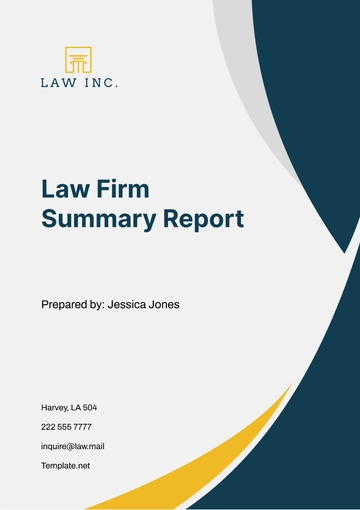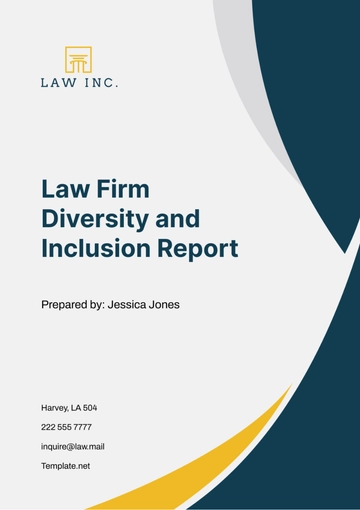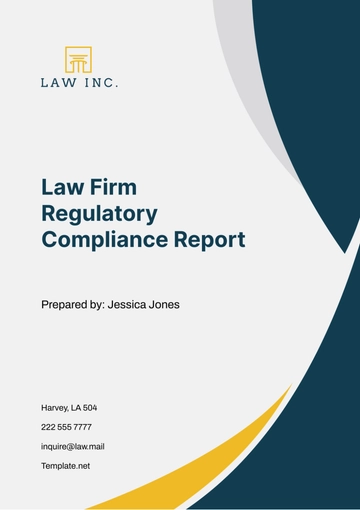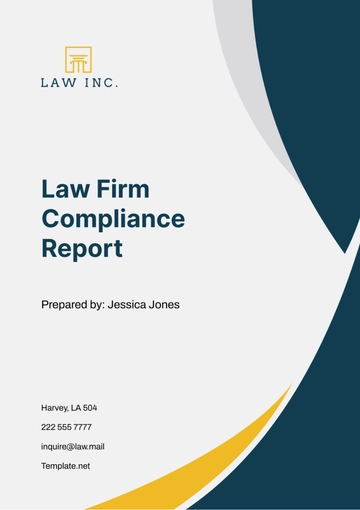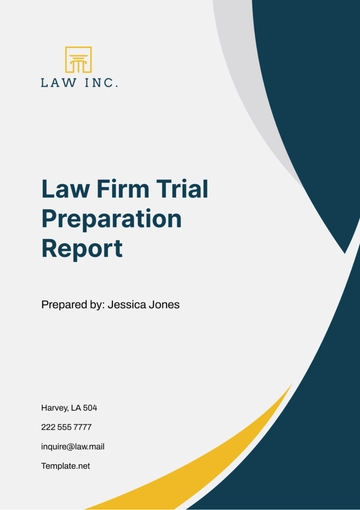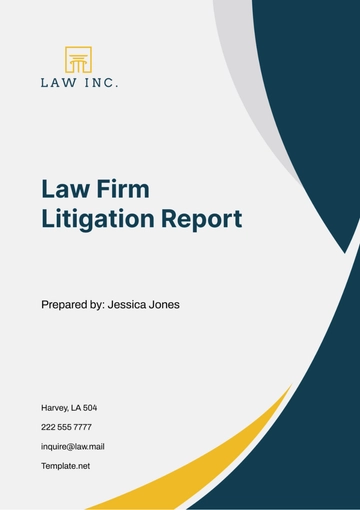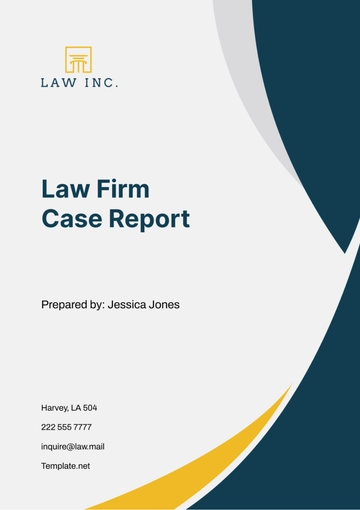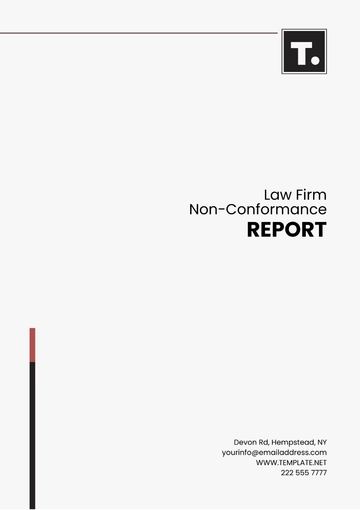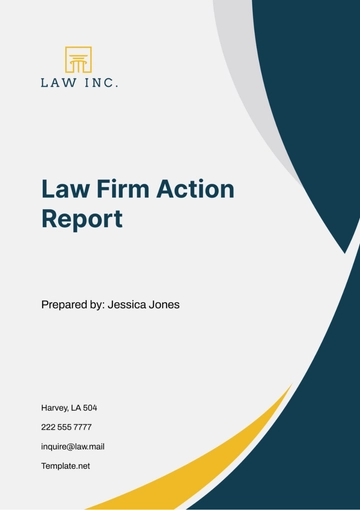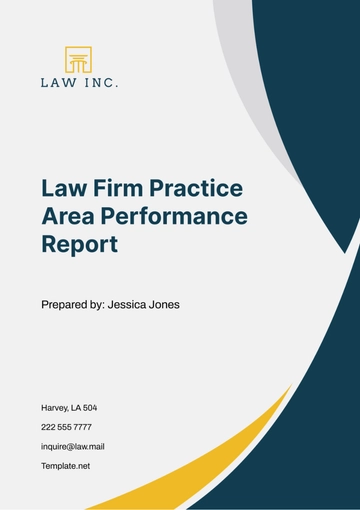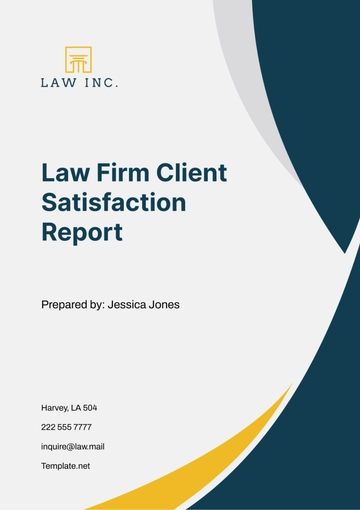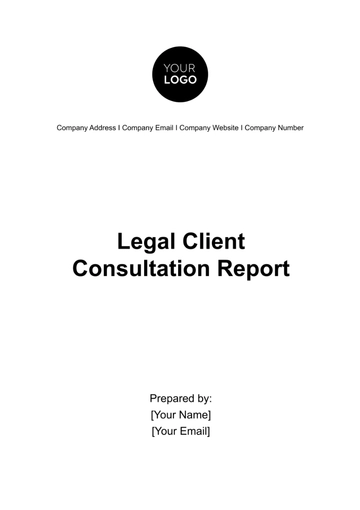Free Law Firm Diversity and Inclusion Report

I. Executive Summary
This report synthesizes the current status, challenges, and future strategies of diversity and inclusion initiatives at [Your Company Name]. It highlights our commitment to fostering an inclusive environment where diverse talents thrive. Key findings indicate progress in gender diversity with a balanced representation across junior roles, but ethnic diversity and representation in senior positions lag behind industry benchmarks. This report outlines our plans to address these disparities and strengthen our diversity efforts.
II. Introduction
Diversity and inclusion are critical to the success and ethical foundation of [Your Company Name]. They enhance our ability to serve a diverse clientele and foster a workplace that celebrates differences. Over the past decade, our firm has implemented several initiatives aimed at increasing diversity across all levels but recognizes the need for continuous improvement. This report uses the following definitions:
Diversity: The representation of varied identities and differences (race, sex, age, etc.).
Inclusion: The practice of creating environments in which any individual or group can be and feel welcomed, respected, supported, and valued.
III. Methodology
To provide a comprehensive understanding of the current state of diversity and inclusion within [Your Company Name], we employed a multi-method approach:
Employee Surveys: Custom-designed surveys were distributed electronically to all employees across our 15 global offices. The survey included questions related to experiences of inclusion, perceived opportunities for advancement, and suggestions for improving workplace diversity.
Data Analysis: We extracted and anonymized employee data from our HR database, covering a range of variables including age, gender, ethnicity, disability status, tenure, and role within the company. We performed statistical analyses to identify trends and disparities.
Focus Groups: Conducted over three months, these sessions gathered qualitative insights from diverse employee groups, facilitating deeper discussions about personal experiences and perceived barriers to inclusion.
Industry Benchmarking: We consulted published reports and databases to compare our diversity metrics against those of peer institutions, identifying industry standards and areas for improvement.
IV. Current Status of Diversity and Inclusion
Demographic Breakdown
This section presents a detailed view of the firm's workforce composition as of [Year]:
Gender: 50% female, 48% male, 2% non-binary.
Ethnicity: 60% White, 18% Hispanic, 12% Black, 8% Asian, 2% Other.
Disability: 5% of employees identified as having a disability.
Leadership Demographics by Gender and Ethnicity
Position | Gender Distribution | Ethnicity Distribution |
|---|---|---|
Senior Management | 70% Male, 30% Female | 80% White, 20% Other |
Mid-Level Management | 60% Male, 40% Female | 70% White, 30% Other |
Junior Staff | 50% Male, 48% Female, 2% Non-binary | 60% White, 40% Other |
V. Assessment and Analysis
Our analysis revealed several key trends:
There has been a consistent increase in female representation at the junior level, up by 5% over the last five years.
Ethnic minorities are underrepresented at all levels, particularly in senior management roles.
Disability inclusion has seen minimal progress, with only a marginal increase in representation over the past decade.
Comparative analysis with industry benchmarks indicates that while our gender diversity at junior levels is aligned with sector averages, our figures for senior roles and ethnic diversity fall below standard.
VI. Challenges and Barriers
The pursuit of enhanced diversity and inclusion within [Your Company Name] faces several internal and external challenges:
Internal Challenges
Unconscious Bias: Despite ongoing training, unconscious biases continue to affect hiring and promotion decisions. Addressing this requires more than training; it necessitates a cultural shift within the firm.
Inflexible Work Arrangements: Current work policies may not accommodate diverse needs, particularly affecting employees with disabilities or caregiving responsibilities.
Lack of Visibility: Underrepresented groups often lack visibility in high-impact roles, which can hinder career progression.
External Challenges
Competitive Talent Market: There is fierce competition for highly qualified candidates from underrepresented backgrounds.
Socioeconomic Barriers: These barriers can limit the professional opportunities available to potential candidates before they even reach the job market.
Cultural Perceptions: The perception of the legal industry as being predominantly white and male can deter potential candidates from diverse backgrounds.
VII. Objectives and Goals
To address these challenges and promote a truly inclusive workplace, [Your Company Name] has set the following strategic objectives:
Short-term Goals (1-3 Years):
Increase Representation | Aim to increase ethnic minority representation in senior management from 20% to 25%. |
Implement Comprehensive Bias Training | Roll out an advanced training program focused on mitigating unconscious bias, with mandatory participation for all management levels. |
Develop Flexible Work Policies | Introduce flexible working hours and remote work options to accommodate diverse employee needs, aiming to improve work-life balance and employee satisfaction. |
Long-term Goals (3-5 Years)
Achieve Gender Parity in Leadership | Strive for a 50-50 gender split in senior management roles. |
Establish Outreach Programs | Create partnerships with high schools and universities in underserved communities to foster a more diverse candidate pipeline. |
Global Inclusion Standards | Implement a global inclusion standard across all offices to ensure consistent practices and culture, regardless of location. |
VIII. Strategy and Action Plan
To achieve these objectives, [Your Company Name] will implement the following strategies:
Recruitment
Diverse Sourcing: Partner with organizations and job boards that cater to underrepresented groups. Develop internship programs with historically Black colleges and universities (HBCUs), Hispanic-serving institutions (HSIs), and women's colleges.
Blind Recruitment Process: Implement a blind recruitment process where certain identifying details are removed from applications to focus on skills and qualifications.
Retention
Mentorship Programs: Establish mentorship programs pairing senior leaders with junior staff from underrepresented groups to enhance professional development opportunities.
Employee Resource Groups (ERGs): Support the formation and activities of ERGs that cater to various demographics, providing a forum for support and advocacy within the firm.
Promotion
Clear Career Pathways: Clearly define criteria for promotion and ensure these are transparent and communicated to all employees. Regularly review and adjust these criteria to remove biases.
Regular Review and Feedback: Implement a semi-annual review process that includes feedback from a diverse panel, ensuring fair and comprehensive evaluations.
Culture
Inclusion Workshops: Conduct regular inclusion workshops to address specific issues such as cross-cultural communication, gender sensitivity, and accommodation of disabilities.
Visible Commitment: Highlight the importance of diversity and inclusion through regular communications from top management, including updates on progress and recognition of diversity champions within the firm.
IX. Accountability and Monitoring
To ensure accountability and the effective monitoring of our diversity initiatives, we will implement the following measures:
Diversity Oversight Committee: This senior-level committee will meet monthly to review progress against diversity goals, discuss challenges, and adapt strategies as needed.
Regular Employee Feedback: Annual surveys and focus groups will be conducted to gather comprehensive feedback from employees about the effectiveness of diversity initiatives.
Data-Driven Approach: Continual analysis of workforce data to track diversity metrics and make informed decisions.
Key Performance Indicators for Diversity Initiatives
Initiative | Metric | Frequency of Review |
|---|---|---|
Recruitment from Diverse Backgrounds | Percentage increase in candidates from underrepresented groups | Quarterly |
Mentorship Programs | Participation rates and satisfaction among mentees | Bi-annually |
Inclusion Training Programs | Pre- and post-training assessment scores | Annually |
X. Conclusion
Our analysis and the strategies outlined in this report underline [Your Company Name]'s unwavering commitment to advancing diversity and inclusion within our workforce. We acknowledge the gaps that exist and are dedicated to implementing robust measures to address these issues. Through sustained efforts and accountability, we aim to not only meet but exceed industry standards, setting a new benchmark for inclusivity and diversity within the legal sector.
- 100% Customizable, free editor
- Access 1 Million+ Templates, photo’s & graphics
- Download or share as a template
- Click and replace photos, graphics, text, backgrounds
- Resize, crop, AI write & more
- Access advanced editor
Advance inclusivity with Template.net's Law Firm Diversity and Inclusion Report Template. Designed to track and enhance diversity initiatives, this template is fully customizable and editable via our Ai Editor Tool. Measure progress, identify challenges, and promote a more inclusive workplace culture. An essential tool for law firms committed to diversity, exclusively available at Template.net.
You may also like
- Sales Report
- Daily Report
- Project Report
- Business Report
- Weekly Report
- Incident Report
- Annual Report
- Report Layout
- Report Design
- Progress Report
- Marketing Report
- Company Report
- Monthly Report
- Audit Report
- Status Report
- School Report
- Reports Hr
- Management Report
- Project Status Report
- Handover Report
- Health And Safety Report
- Restaurant Report
- Construction Report
- Research Report
- Evaluation Report
- Investigation Report
- Employee Report
- Advertising Report
- Weekly Status Report
- Project Management Report
- Finance Report
- Service Report
- Technical Report
- Meeting Report
- Quarterly Report
- Inspection Report
- Medical Report
- Test Report
- Summary Report
- Inventory Report
- Valuation Report
- Operations Report
- Payroll Report
- Training Report
- Job Report
- Case Report
- Performance Report
- Board Report
- Internal Audit Report
- Student Report
- Monthly Management Report
- Small Business Report
- Accident Report
- Call Center Report
- Activity Report
- IT and Software Report
- Internship Report
- Visit Report
- Product Report
- Book Report
- Property Report
- Recruitment Report
- University Report
- Event Report
- SEO Report
- Conference Report
- Narrative Report
- Nursing Home Report
- Preschool Report
- Call Report
- Customer Report
- Employee Incident Report
- Accomplishment Report
- Social Media Report
- Work From Home Report
- Security Report
- Damage Report
- Quality Report
- Internal Report
- Nurse Report
- Real Estate Report
- Hotel Report
- Equipment Report
- Credit Report
- Field Report
- Non Profit Report
- Maintenance Report
- News Report
- Survey Report
- Executive Report
- Law Firm Report
- Advertising Agency Report
- Interior Design Report
- Travel Agency Report
- Stock Report
- Salon Report
- Bug Report
- Workplace Report
- Action Report
- Investor Report
- Cleaning Services Report
- Consulting Report
- Freelancer Report
- Site Visit Report
- Trip Report
- Classroom Observation Report
- Vehicle Report
- Final Report
- Software Report


